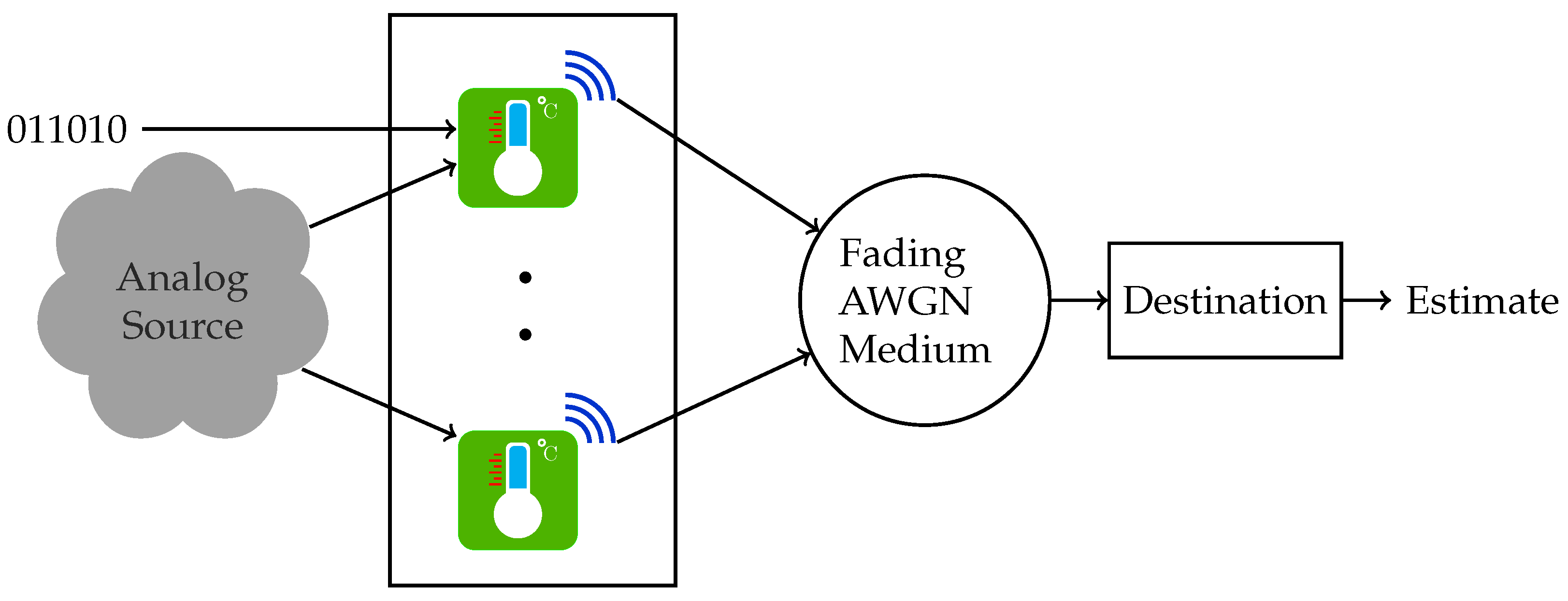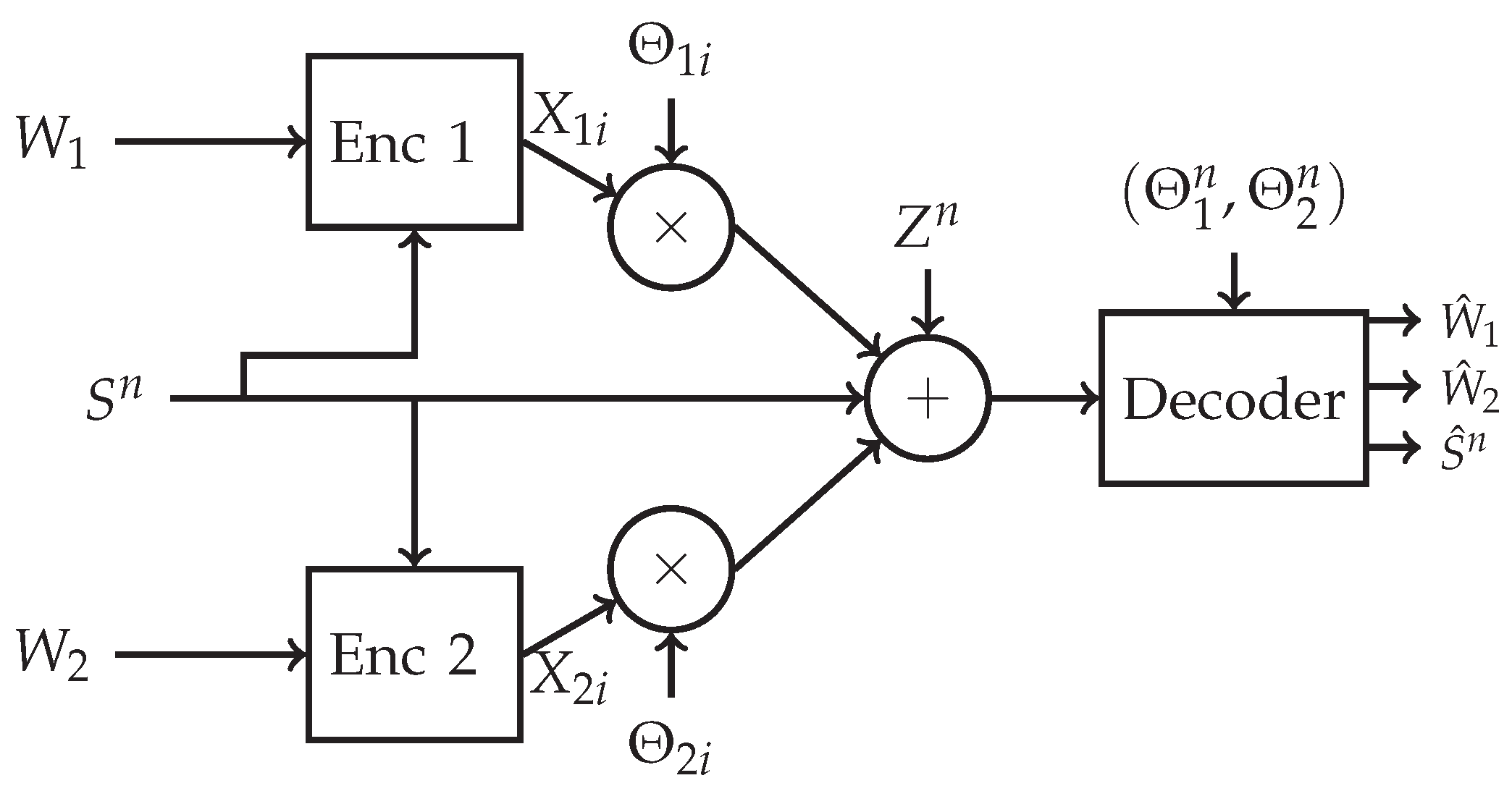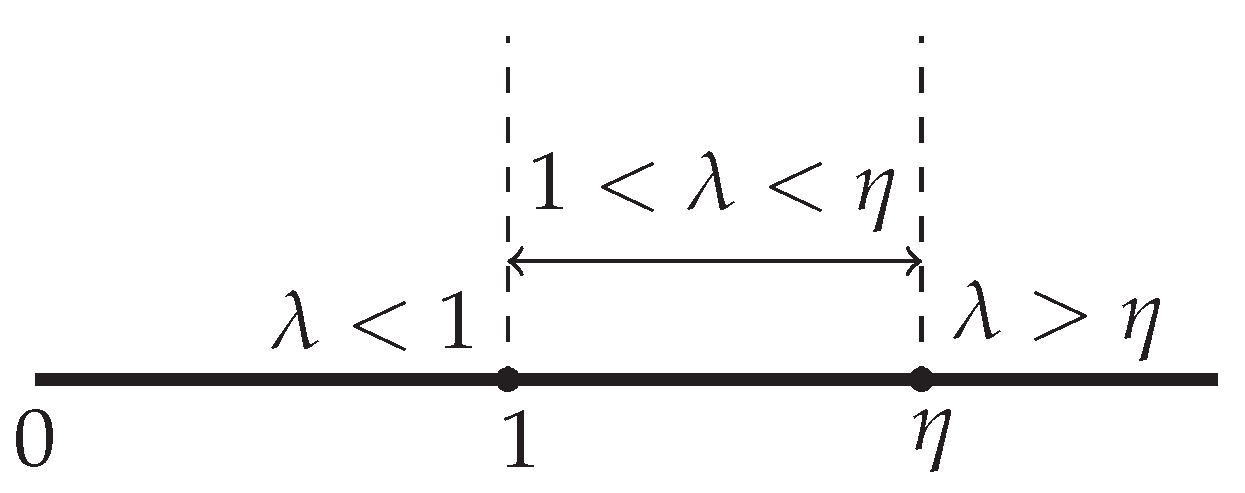Lossy State Communication over Fading Multiple Access Channels
Abstract
:1. Introduction
2. Literature Review
- Analysis of the State of the art and Research gaps: We identify the following crucial aspects.
- We note that none of the works above consider joint state estimation along with message communication over state-dependent multi-terminal settings with noncausal transmitter state information, which is highly relevant in applications like the joint sensing and communication setting in Figure 1. This is addressed in this paper.
- While there exist system-level guidelines and waveform design specifications for such systems, a network information-theoretic analysis of the absolute performance capabilities of joint sensing and communication systems that take into account practical limitations has not been addressed in the literature, which we undertake here.
- Moreover, none of the works on joint communication and estimation mentioned above take fading links into account. Fading is an impairment that must be accounted for in practical wireless communication channel models, such as the joint sensing and communication application shown in Figure 1. This is another gap in the literature that this paper seeks to fill by investigating joint communication and estimation over state-dependent multi-user fading channels, the point-to-point counterpart of which was addressed by the author in [35].
- The key novelty of our work is that it is the first instance where joint communication and estimation have been considered in a multiple-user setting that also accounts for fading links, as opposed to previous works, which focused only on non-fading links.
- Moreover, it is the first work that considers non-causal state information (as opposed to causal or strictly causal) at the transmitter in a fading multi-user scenario which is practically relevant as described in the sensor network example from Figure 1.
- Furthermore, we undertake a comprehensive network information-theoretic study of the fundamental performance limits of such joint communication and estimation settings, which is lacking in the literature. Please refer to Table 1, which highlights our contributions in this paper with respect to the existing works.
- Summary of contributions: We list them below. See also the contribution summary Table 1, which emphasizes the novelty of our work with respect to the existing works.
- One of our main contributions in the paper is a complete characterization (Theorem 1) of the rate-distortion trade-off region for joint state estimation and communication over a two-user fading GMAC with the state. The key non-trivial part is the proof of converse, which is given in Section 5.
- We prove that the optimal strategy for the setting under consideration involves uncoded transmissions to amplify the state, along with the superposition of the digital message streams using appropriate Gaussian codebooks and DPC.
- We prove the optimality of uncoded state amplification in the special case where there are no messages to communicate—please refer to the section on implications of our result given after the statement of Theorem 1 for the details.
- Our study gives a network information-theoretic analysis of the fundamental performance limits of joint sensing and communication systems that take into account practical limitations such as fading. This acts as a design directive for realistic systems using joint sensing and transmission anticipated in upcoming wireless standards and points to the relative merits of uncoded communications and joint source-channel coding in such systems.
3. System Model and Results
4. Achievability
5. Converse
5.1. Outer Bound
- Case 1
- (): In this regime, Lemma 2 directly gives a bound on the weighted sum rate.
- Case 2
- (): Since , we havewhere follows from an application of Lemma 2 followed by Lemma 3, and follows from the fact that uncoded transmission of the state by the two users acting as a super-user with power results in the minimal distortion possible [20].
- Case 3
- (): Since , we have
5.2. Equivalence of Inner and Outer Bounds
6. Conclusions
Funding
Institutional Review Board Statement
Informed Consent Statement
Data Availability Statement
Acknowledgments
Conflicts of Interest
Appendix A
Appendix A.1. Proof of Lemma 1
Appendix A.2. Proof of Lemma 2
Appendix A.3. Proof of Lemma 4
References
- Chiriyath, A.R.; Paul, B.; Jacyna, G.M.; Bliss, D.W. Inner bounds on performance of radar and communications co-existence. IEEE Trans. Signal Process. 2015, 64, 464–474. [Google Scholar] [CrossRef]
- Liu, F.; Liu, Y.F.; Li, A.; Masouros, C.; Eldar, Y.C. Cramér-Rao Bound Optimization for Joint Radar-Communication Beamforming. IEEE Trans. Signal Process. 2021, 70, 240–253. [Google Scholar] [CrossRef]
- Shi, C.; Wang, F.; Salous, S.; Zhou, J. Low probability of intercept-based radar waveform design for spectral coexistence of distributed multiple-radar and wireless communication systems in clutter. Entropy 2018, 20, 197. [Google Scholar] [CrossRef] [Green Version]
- Shi, C.; Wang, F.; Salous, S.; Zhou, J.; Hu, Z. Nash bargaining game-theoretic framework for power control in distributed multiple-radar architecture underlying wireless communication system. Entropy 2018, 20, 267. [Google Scholar] [CrossRef] [Green Version]
- Kumari, P.; Choi, J.; González-Prelcic, N.; Heath, R.W. IEEE 802.11 ad-based radar: An approach to joint vehicular communication-radar system. IEEE Trans. Veh. Technol. 2017, 67, 3012–3027. [Google Scholar] [CrossRef] [Green Version]
- Liu, F.; Masouros, C.; Petropulu, A.P.; Griffiths, H.; Hanzo, L. Joint radar and communication design: Applications, state-of-the-art, and the road ahead. IEEE Trans. Commun. 2020, 68, 3834–3862. [Google Scholar] [CrossRef] [Green Version]
- Gaudio, L.; Kobayashi, M.; Caire, G.; Colavolpe, G. On the effectiveness of OTFS for joint radar parameter estimation and communication. IEEE Trans. Wirel. Commun. 2020, 19, 5951–5965. [Google Scholar] [CrossRef]
- Xu, W.; Alshamary, H.A.; Al-Naffouri, T.; Zaib, A. Optimal joint channel estimation and data detection for massive SIMO wireless systems: A polynomial complexity solution. IEEE Trans. Inf. Theory 2020, 66, 1822–1844. [Google Scholar] [CrossRef]
- Pucci, L.; Paolini, E.; Giorgetti, A. System-level analysis of joint sensing and communication based on 5G new radio. IEEE J. Sel. Areas Commun. 2022, 40, 2043–2055. [Google Scholar] [CrossRef]
- Qi, Q.; Chen, X.; Khalili, A.; Zhong, C.; Zhang, Z.; Ng, D.W.K. Integrating Sensing, Computing, and Communication in 6G Wireless Networks: Design and Optimization. IEEE Trans. Commun. 2022, 70, 6212–6227. [Google Scholar] [CrossRef]
- Wang, Z.; Mu, X.; Liu, Y.; Xu, X.; Zhang, P. NOMA-aided joint communication, sensing, and multi-tier computing systems. IEEE J. Sel. Areas Commun. 2023, 41, 574–588. [Google Scholar] [CrossRef]
- Kobayashi, M.; Caire, G.; Kramer, G. Joint state sensing and communication: Optimal tradeoff for a memoryless case. In Proceedings of the 2018 IEEE International Symposium on Information Theory (ISIT), Vail, CO, USA, 17–22 June 2018; pp. 111–115. [Google Scholar]
- Kobayashi, M.; Hamad, H.; Kramer, G.; Caire, G. Joint state sensing and communication over memoryless multiple access channels. In Proceedings of the 2019 IEEE International Symposium on Information Theory (ISIT), Paris, France, 7–12 July 2019; pp. 270–274. [Google Scholar]
- Ahmadipour, M.; Wigger, M.; Kobayashi, M. Joint sensing and communication over memoryless broadcast channels. In Proceedings of the 2020 IEEE Information Theory Workshop (ITW), Riva del Garda, Italy, 11–15 April 2021; pp. 1–5. [Google Scholar]
- Ahmadipour, M.; Wigger, M.; Kobayashi, M. Coding for Sensing: An Improved Scheme for Integrated Sensing and Communication over MACs. arXiv 2022, arXiv:2202.00989. [Google Scholar]
- Ahmadipour, M.; Kobayashi, M.; Wigger, M.; Caire, G. An information-theoretic approach to joint sensing and communication. IEEE Trans. Inf. Theory 2023, 2023, 3176139. [Google Scholar] [CrossRef]
- Costa, M.H. Writing on dirty paper (corresp.). IEEE Trans. Inf. Theory 1983, 29, 439–441. [Google Scholar] [CrossRef]
- Steinberg, Y.; Merhav, N. Identification in the presence of side information with application to watermarking. IEEE Trans. Inf. Theory 2001, 47, 1410–1422. [Google Scholar] [CrossRef] [Green Version]
- Weingarten, H.; Steinberg, Y.; Shamai, S. The capacity region of the Gaussian multiple-input multiple-output broadcast channel. IEEE Trans. Inf. Theory 2006, 52, 3936–3964. [Google Scholar] [CrossRef]
- Sutivong, A.; Chiang, M.; Cover, T.M.; Kim, Y.H. Channel capacity and state estimation for state-dependent Gaussian channels. IEEE Trans. Inf. Theory 2005, 51, 1486–1495. [Google Scholar] [CrossRef]
- Zhang, W.; Vedantam, S.; Mitra, U. Joint transmission and state estimation: A constrained channel coding approach. IEEE Trans. Inf. Theory 2011, 57, 7084–7095. [Google Scholar] [CrossRef] [Green Version]
- Tian, C.; Bandemer, B.; Shamai, S. Gaussian State Amplification with Noisy Observations. IEEE Trans. Inf. Theory 2015, 61, 4587–4597. [Google Scholar] [CrossRef]
- Bross, S.I.; Lapidoth, A. The Gaussian Source-and-Data-Streams Problem. IEEE Trans. Commun. 2019, 67, 5618–5628. [Google Scholar] [CrossRef]
- Zhao, Y.; Chen, B. Capacity theorems for multi-functioning radios. In Proceedings of the 2014 IEEE International Symposium on Information Theory (ISIT), Honolulu, HI, USA, 29 June–4 July 2014; pp. 2406–2410. [Google Scholar]
- Ramachandran, V.; Pillai, S.R.B.; Prabhakaran, V.M. Joint state estimation and communication over a state-dependent Gaussian multiple access channel. IEEE Trans. Commun. 2019, 67, 6743–6752. [Google Scholar] [CrossRef]
- Koyluoglu, O.O.; Soundararajan, R.; Vishwanath, S. State Amplification Subject to Masking Constraints. IEEE Trans. Inf. Theory 2016, 62, 6233–6250. [Google Scholar] [CrossRef] [Green Version]
- Merhav, N.; Shamai, S. Information rates subject to state masking. IEEE Trans. Inf. Theory 2007, 53, 2254–2261. [Google Scholar] [CrossRef]
- Bross, S.I. Message and Causal Asymmetric State Transmission Over the State-Dependent Degraded Broadcast Channel. IEEE Trans. Inf. Theory 2020, 66, 3342–3365. [Google Scholar] [CrossRef]
- Tse, D.N.C.; Hanly, S.V. Multiaccess fading channels. I. Polymatroid structure, optimal resource allocation and throughput capacities. IEEE Trans. Inf. Theory 1998, 44, 2796–2815. [Google Scholar] [CrossRef] [Green Version]
- Das, A.; Narayan, P. Capacities of time-varying multiple-access channels with side information. IEEE Trans. Inf. Theory 2002, 48, 4–25. [Google Scholar] [CrossRef]
- Sreekumar, S.; Dey, B.K.; Pillai, S.R.B. Distributed rate adaptation and power control in fading multiple access channels. IEEE Trans. Inf. Theory 2015, 61, 5504–5524. [Google Scholar] [CrossRef] [Green Version]
- Vaze, C.S.; Varanasi, M.K. Dirty paper coding for fading channels with partial transmitter side information. In Proceedings of the 2008 42nd Asilomar Conference on Signals, Systems and Computers, Pacific Grove, CA, USA, 26–29 October 2008; pp. 341–345. [Google Scholar]
- Rini, S.; Shamai, S. The impact of phase fading on the dirty paper coding channel. In Proceedings of the 2014 IEEE International Symposium on Information Theory, Honolulu, HI, USA, 29 June–4 July 2014; pp. 2287–2291. [Google Scholar]
- Goldsmith, A.J.; Varaiya, P.P. Capacity of fading channels with channel side information. IEEE Trans. Inf. Theory 1997, 43, 1986–1992. [Google Scholar] [CrossRef] [Green Version]
- Ramachandran, V. Joint Communication and State Estimation over a State-Dependent Fading Gaussian Channel. IEEE Wirel. Commun. Lett. 2022, 11, 367–370. [Google Scholar] [CrossRef]
- Steinberg, Y. Coding for the degraded broadcast channel with random parameters, with causal and noncausal side information. IEEE Trans. Inf. Theory 2005, 51, 2867–2877. [Google Scholar] [CrossRef]
- Kim, Y.H.; Sutivong, A.; Sigurjonsson, S. Multiple user writing on dirty paper. In Proceedings of the 2004 IEEE International Symposium on Information Theory, Chicago, IL, USA, 27 June–2 July 2004; p. 534. [Google Scholar]
- Gastpar, M. Uncoded transmission is exactly optimal for a simple Gaussian sensor network. IEEE Trans. Inf. Theory 2008, 54, 5247–5251. [Google Scholar] [CrossRef]
- Gelfand, S.; Pinsker, M. Coding for channels with random parameters. Probl. Control. Inf. Theory 1980, 9, 19–31. [Google Scholar]
- Cover, T.M.; Thomas, J.A. Elements of Information Theory; John Wiley & Sons: Hoboken, NJ, USA, 2012. [Google Scholar]



| Single-User (Noncausal) | BC (Causal) | MAC (Noncausal) | |||
|---|---|---|---|---|---|
| No Fading | Fading | No Fading | No Fading | Fading | |
| No State Estimation | [17] | [32] | [36] | [37] | This work |
| State Estimation | [20] | This work | [28] | [25] | This work |
Disclaimer/Publisher’s Note: The statements, opinions and data contained in all publications are solely those of the individual author(s) and contributor(s) and not of MDPI and/or the editor(s). MDPI and/or the editor(s) disclaim responsibility for any injury to people or property resulting from any ideas, methods, instructions or products referred to in the content. |
© 2023 by the author. Licensee MDPI, Basel, Switzerland. This article is an open access article distributed under the terms and conditions of the Creative Commons Attribution (CC BY) license (https://creativecommons.org/licenses/by/4.0/).
Share and Cite
Ramachandran, V. Lossy State Communication over Fading Multiple Access Channels. Entropy 2023, 25, 588. https://doi.org/10.3390/e25040588
Ramachandran V. Lossy State Communication over Fading Multiple Access Channels. Entropy. 2023; 25(4):588. https://doi.org/10.3390/e25040588
Chicago/Turabian StyleRamachandran, Viswanathan. 2023. "Lossy State Communication over Fading Multiple Access Channels" Entropy 25, no. 4: 588. https://doi.org/10.3390/e25040588
APA StyleRamachandran, V. (2023). Lossy State Communication over Fading Multiple Access Channels. Entropy, 25(4), 588. https://doi.org/10.3390/e25040588








